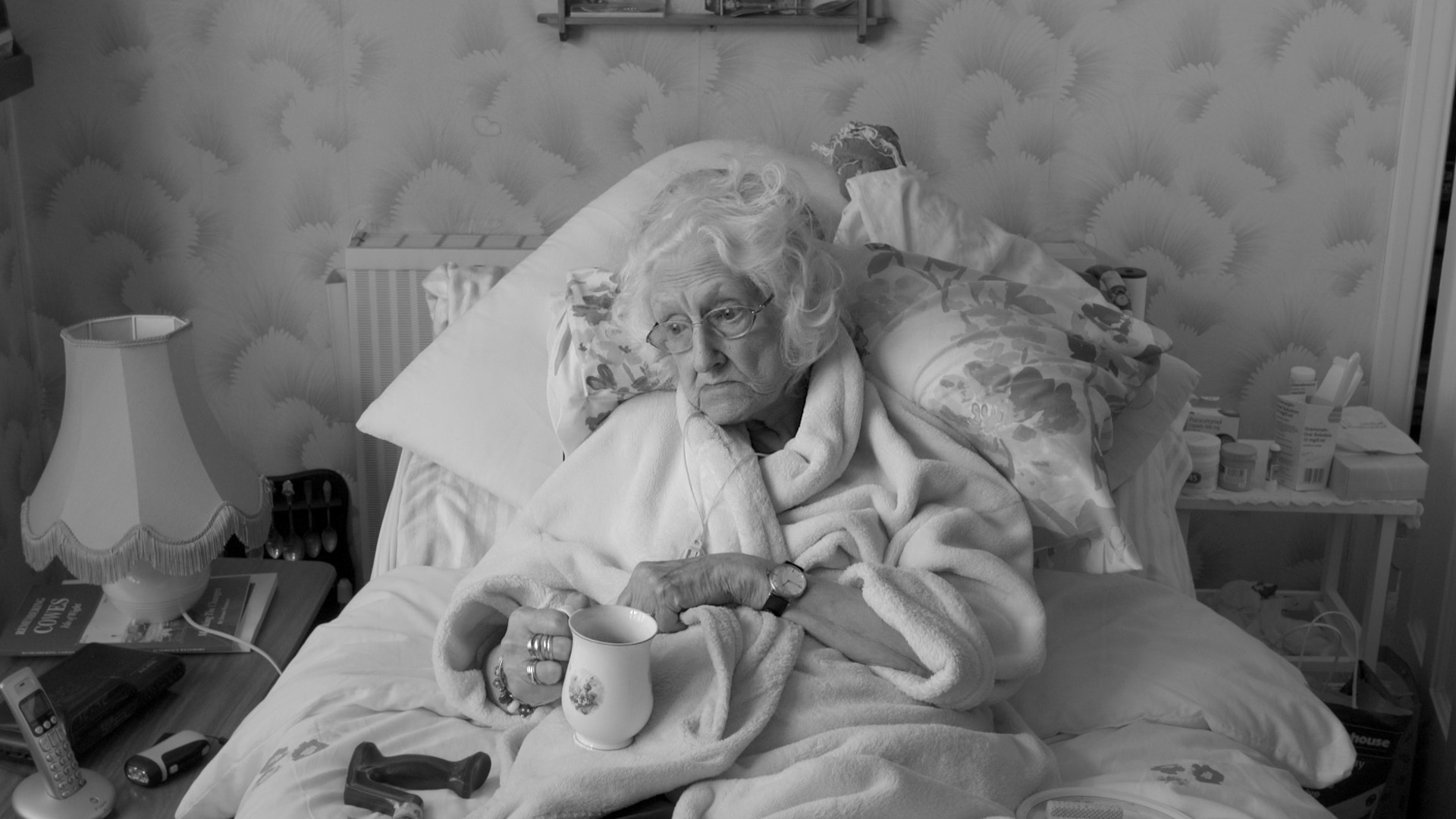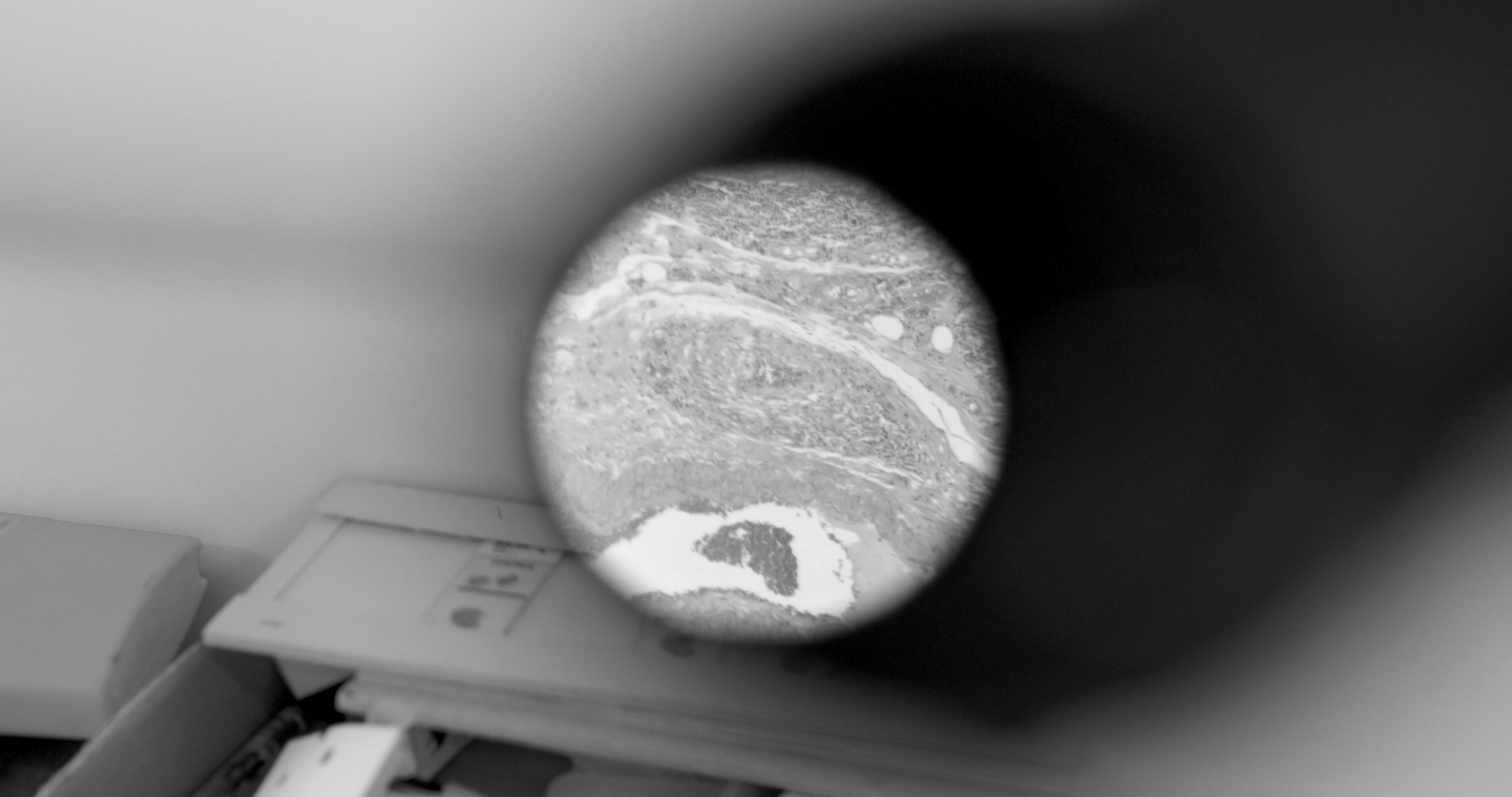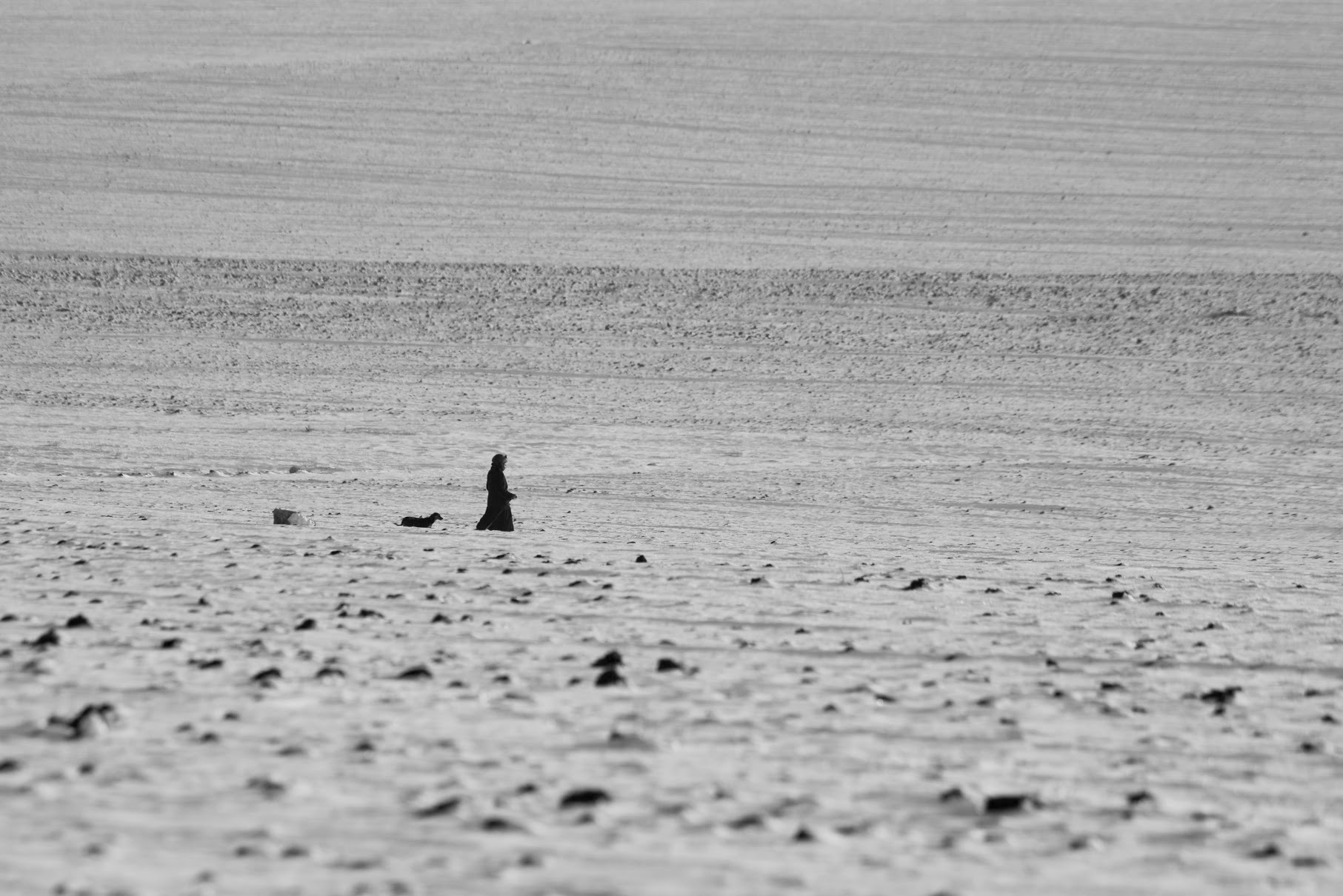Kitty Grady
The Temporality of Care
In her 2017 book Enduring Time, the writer and psychotherapist Lisa Baraitser explores instances where time can seem suspended, no longer progress or flow but instead, seem to ‘well up’ or pool. She selects temporalities such as ‘waiting, staying, delaying, enduring, persisting, repeating, maintaining, preserving and remaining’ in order to explore the continuous, and often arduous present of certain experiences: imprisonment, bereavement, the ‘never-ending’ process of psychoanalysis, the repetitive work of waste collectors, that exist in the seams of the relentlessly forward-moving time of capitalist production. These atemporal modes of being lead to a more crystalline sense of time, devoid of action, but more perspicuous and acute. Baraitser sees this ‘dead’ time as deeply qualitative, meaningful and relational, challenging our willingness to care for one another and our world, to stay by other humans (and non-human) life, to choose also to go against the flow of time. It is sustained work that sustains our world; we pool our time so that we might keep one another afloat.
‘When do you think this will end?’ is what my grandma, who has been isolating alone in rural Kent, repeatedly asks me when I call her. The arrested temporality of the pandemic has divided us into two kingdoms: the formerly time-starved, for whom this catastrophe is a luxurious chance to ‘reset’ — as ran the August cover of British Vogue magazine — a ‘once-in-a-century’ deceleration of 24/7 culture, during which we curiously re-notice the cycles of nature, the position of the stars and the moon, our subconscious resurfacing in strange dreams. For the second kingdom — of the lonely, the shielding, the homeless, the ill, the unemployed and precarious — Covid-19 might be more likely to have the unending intensity of a nightmare. A special report by the Wellcome Collection’s ongoing project Waiting Times, describes the pandemic as a ‘crisis of time — a moment where questions of temporality and its relation to care have come urgently to the fore’. We have seen this partly in the rise of mutual aid and volunteer groups, but largely in a renewed attention to ‘key workers’ — nurses, doctors, carers, bus drivers, supermarket workers as well as unpaid carers — who keep going as before, putting themselves at risk in the process, so that crisis is mitigated and our world might be maintained for a future, even as it appears to have stopped.
Thinking about my grandma, and thinking about Covid-19, I found this relation between time’s suspension and care elucidated in two documentaries, one I watched recently and the other less recently: Island (2017) directed by Steven Eastwood and Honeyland (2019) directed by Ljubomir Stefanov and Tamara Kotevska. Island tracks the last year in the life of four terminally ill patients: Alan, Jamie, Mary and Rory at a hospice on the Isle of Wight. Honeyland follows Hatizde, a beekeeper in rural Macedonia who also cares for her eighty-five-year-old, bedbound mother. Despite portraying the ‘chronic’ time of terminal illness and old age, both films show the liveliness of dying time, the rhythms and relationality of care. Both films pay close attention to the way care operates within the interstices of — and against — productive, forward-looking time, while they make a case for care’s profound importance, even, and perhaps most importantly, when what we are caring for is totally doomed.
‘The film appears buoyant, afloat’, reads Island’s promotional description. This buoyancy is related to the documentary’s temporality as much as its geography, as Eastwood presents the time of terminal illness as non-linear, non-progressive. ‘Time is a peculiar thing. It’s just a way of chopping up a period. Say we organize to meet at 3pm tomorrow, it’s useful because we both know when 3pm is’, says Alan to the camera, his speech steadily paced, without rushing into the next sentence, ‘But tomorrow at 3pm it’ll be now. That moment moves. There is no time but the now. We live in the eternal now.’ Cleared of action, and consisting of an uneventful or perpetual waiting scenes such as these are Deleuzian time-images, without causality into a future. ‘They’ve not come in today’, says Mary, looking out the window, drinking tea in bed [Figure 1]. ‘How’s the time?’ Alan later asks his relative at his bedside, unbelieving when she answers that it is ‘12.31, Have you been asleep all morning?’ A repeated motif throughout the documentary shows Alan smoking outside the hospice. As if a hallucination, we see him reclining in his hospice bed, taking slow drags, not tapping off the ash but letting it build up — a visual metaphor which encapsulates the eternal present, but nonetheless entropic time of terminal illness, each breath taking away from a total sum. Unhinged from any decisive narrative ‘plot’ — these chronic scenes contrast with images of the island’s regular, productive rhythms — the ebb and flow of ferries that arrive and leave, bringing in tourists, school children and workers. In the atemporal ordering of the film’s sequence, Eastwood also plays with the ‘futurity’ of death — the opening scene shows Alan’s body being placed in a coffin before we see him alive and healthy in a subsequent scene, then all of a sudden thinner, deteriorated, then his funeral, before finally, healthy again. The causality of life to death doesn’t flow forwards or backwards in Island, present and past converge and overlap, an asynchronicity that, like a life-jacket, eludes death by floating.

Figure. 1
At shifting intervals we watch the nurses’ regular meetings, where they share notes about their patients. The content of their labour is similarly elastic. They move seamlessly from discussing medication, to organizing birthday parties, to analysing the health implications of this for that patient: from the technical to the affective and back again: ‘His condition might deteriorate after [the party]. We’ll need to be careful’. The care of the nurses does not end with the death of the person cared for, but extends into the time after death. After discussing his vivid ‘plans’ for the afterlife, where he will meet his wife Valerie again, when Alan does die, his nurses continue to relate to him. We see one checking for any residual pulse, after he has taken his last breath. Then, cleaning his body, combing his hair, they address him as if still living, their speech moving from the third to the second person to acnowledge his elusive position between this life and the one after: ‘He’s very peaceful — aren’t you Alan?’
Honeyland also depicts the chronic time of end-of-life care and its ethical demands. ‘I’ve become like a tree. I’m not dying. I’m just making your life a misery’, says Hatidze’s mother, vocalizing the sad feeling that she is not ‘dying quickly enough’, and that she is burdening her daughter, stopping her life from ‘flowing’ forward. People who care unofficially for others, mainly family members, often have to pause their own plans in order to do so, give up their jobs or juggle it alongside other domestic and professional labour. Hatidze’s care for her mother is shown in mostly candle-lit scenes in their small house, work that burns the ends of the day, following the sunlit scenes of her work as a beekeeper, the film’s main ‘intrigue’. Her care is also an endured work of maintenance — feeding her, changing the bandages of the wound on her face (which, sprawling and leaky, clearly toll bad news), as well as performing tasks that aren’t a question of life-and-death, but are small acts of devotion that give her life quality. She washes and dyes her hair for her, buys her a fan, feeds her spoons of honey, gives her nourishing fruit: ‘It’s a local watermelon, not one you buy at the supermarket. It’s sweet.’ In her essay ‘In Defense of Saccharin(e)’ (2015), Leslie Jamison writes how sweetness is often figured negatively, as sentimental, flimsy and non-durable: ‘Honeymoon means days that are too sweet to last [...] the state of being intoxicated by the taste of honey — cloying, consuming — is juxtaposed as innocence against the harder task of human relation.’ In Honeyland, the film’s rushes of ‘sweetness’ — literal and metaphorical — are depicted in full knowledge of the hard task of sustaining human relations. The sweet does not come without its difficulties — feeding her mother oats and honey, Hatidze gets frustrated when her mother won’t eat it and throws it angrily on the floor, and in a later scene her good, saintly bedside manner dissolves when her mother cannot hear her niceties, becoming frustrated and shouting them increasingly loudly and heavy handedly. The work of sweetness is sometimes hard, but it provides a deep quality of sustenance, a reason to keep going, or at least not to die just yet.
All care is atemporal, out of joint. Everyone who cares was once cared for, and everyone who cares now, will be cared for again, we grow out of and deteriorate into positions where we will need to be cared for: ‘Remember when you used to help me’, muses Hatidze. But to adopt the position of care itself might also be seen as a rejection of rectilinear progression. In Inclinations: A Critique of Rectitude (2016), the feminist philosopher Adriana Cavarero critiques the ‘egocentric verticality’ of the fully developed, upright male. As exemplified in Mary’s inclined body, arms outstretched towards the infant Jesus, she argues for a feminine-coded paradigm of ethical relationality that is asymmetrical: bent over and inclined as it tends to someone or thing smaller or frailer than us. It is a ‘postural ethics’ that also involves making ourselves somewhat unstable, vulnerable, moving away from our vertical axis. As well as her frail mother, many small creatures: children, cats, dogs, turtles — as well as bees — populate the film, and Hatidze is shown inhabiting the scene with them harmoniously. In the opening shots we see her precariously scaling mountains with sheer drops as she checks one of her sources, her archaic techniques based on sharing: ‘Half for them, half for me’ goes her mantra. Triangulating the inclined structure we see her teaching her neighbour’s little boy about her techniques — her arm angled up to them as she looks down to him or leaning down to her mother to feed, bathe and talk to her. [Figures. 2+3].


Figures. 2 + 3
Yet Haditze’s tender, feminine posturing is threatened by a violent, masculinized desire for development and progression at all costs. The more industrialised techniques of the boy’s father, who, despite his son’s pleas, involves plundering the honeycomb dry in order to maximize instant profits, killing many of Hatidze’s bees in the process. In Island, masculinity also threatens the caring geometries of inclination. In one scene, Jamie is shown watching football with his friends in his hospice room. We first see a close up of his Chelsea shirt and tattooed arms, collaged over with hospital wristbands, tubes and plasters. We watch the nurse as she silently performs an injection and kneels at his feet to drain his catheter. The scene shows Jamie as supported, cared for, inclined to – diagonally by the nurse and more horizontally by his friends, who inquire about the procedure without any disgust, only gently teasing him. Jamie’s fragility is highlighted: his quiet, slurring voice signalling tiredness, and he eventually falls asleep. Yet to the same friends we also earlier hear Jamie describing the process of getting an enema from a nurse, describing it as being ‘finger-blasted’, her hands like ‘King Kong’ and he jokingly makes grunting noises. This is a reminder of how care, as feminized labour, necessarily opens itself to forms of misogyny and abuse. Furthermore, whilst Cavarero’s postural imaginary sees the frail, small, ‘cute’ things as exemplary of this dynamics, these instances remind that care also involves caring for those who might hurt us in return, and the way to care is to place oneself in a delicate position of both power and vulnerability.
Caring involves being part of an assemblage, where one undoes oneself for a heterogeneous other, and enters into multifarious, non-linear temporalities. Hatizde’s care for her mother in her simple home, is not a Bachelardian hut, a container for emotions, but opens out onto a wider universe. Her care for the bees is a respect for their time as much as their space; ‘if it’s too early it will collapse’, she warns her neighbour who has also started bee-keeping. Her good nature spirals outwards, infectious. Going to the city, Skopje, to sell her honey, she banters kindly with the market owners who are a little bemused but also charmed by her old-fashioned ways and give her a fan for free which she then gives to her mother. In Island, the hospice is also presented as part of a wider ecosystem. Although ostensibly cut off, the specific geography of Island is rhizomatic, connecting many different human and non-human elements that are interwoven and imbricated, as the titular allusion to John Donne (‘No man is an Island […] every man/ is a piece of the continent, a part of the main’) suggests. Natural images of the ‘Wightlink’ and passenger ferries that bring new people in, images of seagulls and windswept landscapes do not bookend scenes of care but seep into one another seamlessly. The opening images of Alan’s body in a shiny wooden coffin, dead but strangely lifelike in a bright yellow t-shirt rhymes with the following scenes where an overgrown tree blows gently in the wind, and an owl — at first totally still like taxidermy, before blinking, the illusion of death broken. Tying together these images, an owl is then seen on the arm of a hospice patient, a therapeutic partnership of human and non-human beings. As non-familial partnerships, the nurse-patient relationship can also be seen in terms of becoming, an asymmetrical union between strangers of a prolonged, but necessarily limited time frame (ending in either cure or death) that, as in Lauren Berlant’s definition of impasse companionship in Cruel Optimism (2011), doesn’t get ‘too deep in the projecting or embedding [..] doesn’t congeal into a couple form’. Eastwood explains how he noticed that patients would share parts of their personalities or thoughts with nurses that they would never share with their families: ‘This creates a liberating opportunity for the development of new relationships that don’t have to conform to patterns and histories.’
Eastwood’s filmmaking methods can be read as a kind of ‘careful attention’, that gives a reified visibility to the arduous temporalities of the end-of-life. Filmed over 12 months, like the nurses and family members who sit at bedsides, Eastwood ‘spends time’ with his subjects. Alan, Jamie, Mary and Roy all reference Eastwood’s presence at various points, denying him any distanced, egocentric autonomy of the filmmaker, but necessarily entering him also into the caring assemblage. This endured temporality is formalized in his use of the extended long take, which also requires our own endurance and attention as spectators. In With the End in Mind (2019), the palliative care doctor Kathryn Mannix describes the ‘deep analytic attention of the families who sit and wait [...] this is not a passive activity; I am actively, keenly alert, probing her face for clues’ an activity which creates the temporal impression of ‘an eternity’. The film recreates a six-minute vigil for Alan that approximates this eternity.
Having seen him breathing steadily several scenes before, we see him in the same position, but now totally still, perhaps even dead. But unlike a photograph, the moving film indexes his still living body: we first notice the tear coming out of his eye, then tiny quivers of muscles, before he breathes in a sudden, total gasp, and then continues to breathe irregularly at increasingly long intervals, before stopping again. We watch him still for a further moment, holding onto an idea that he might breathe again. As if waking Eastwood from his engrossed attention, the nurse announces: ‘Steven? Steven? Alan’s gone’. The nurse moves in front of the camera to check on her patient. ‘You might get another breath, love’, she says. Yet rather than ask her to move so he can capture the elusive last breath, Eastwood, audibly overwhelmed with emotion, lets her stay there. The screen is now obscured by her purple scrubs, but it is still a total image of care, as we hear her comfort Steven further and ask him calmly if he would like a tea or coffee.
Island also pays attention to the more material, or mechanized sides of ‘care’ that are normally overlooked, and how they are closely linked to the immaterial labour of affective care. A nurse changes Alan’s catheter, gently reassuring him when she sees some blood (‘We’ll keep an eye on it’). The scene cuts to an image of two women in a test lab in white coats working at scientific equipment. The camera focuses on the mechanized movements of the equipment with which the nurses cut them up into tiny, fragile fragments. They then carefully place them on water and then nudge them with tweezers to break them up and put them into petri dishes. Anne Boyer writes in The Undying (2019) that:
The word ‘care’ rarely calls to mind a keyboard […] I care for you suggests a different mode of abstraction (that of feeling) than the measurement of the cell division rate of a tumor (that of pathological fact). But strange reversals reveal themselves during serious illness [...] Our once solid, unpredictable, sensing, spectacularly messy and animal bodies submit — imperfectly, but also intensively — to the abstracting conditions of medicine. Likewise, care becomes vivid and material.

Figure. 4
‘The work of care and the work of data exist in a kind of paradoxical simultaneity, ’ continues Boyer, ‘what both hold in common is that they are done so often by women, and like all that has historically been identified as women’s work it is work that can go by unnoticed. It is often only noted when it is absent: a dirty house attracts more attention than a clean one.’ We see this logic played out in Honeyland. When a mysterious illness kills the neighbour’s cows, the husband hypocritically condemns his wife’s lack of attention: ‘50 died, you should’ve cared more’, ‘you take no care […] God forbid woman, not a bit of care.’ Care is made overtly visible when it goes wrong or is missing, and the onus of blame is invariably placed on women, rather than the structures (lack of funding, bad management, training, understaffing) that lead to these failures of care. It is in this way that we hear about failures of care in the press, and rarely of its continued, sustaining thereness.
With 20,000 UK care home residents dying from Covid-19, and 10,000 excess care home deaths in the March to June period, the pandemic marks such a moment — of care being discussed precisely when it is failing. Yet rather than a failure of care on behalf of workers, it is the care sector itself which has been failed. If the government did indeed put a ‘protective ring’ around care homes, as Health Secretary Matt Hancock dubiously claimed, then its problem was that it was implemented much too late. Whilst concerned care home managers were reportedly asking for government advice from as early as February, the official advice remained relaxed, non-urgent. Rather than acting immediately, in mid-March, Chief Medical Officer Chris Whitty said that the government should avoid doing things ‘too early’ in relation to locking down care homes, despite care home crises already horrifically unfurling in countries such as Spain and Italy — warnings from the future. Fearing a shortage of hospital beds, elderly patients were sent into care homes without being tested, and the usual PPE supplies that would allow appropriate ‘shield nursing’, became scarce and expensive, with the NHS prioritised. The irony of the government’s strategy is that, by taking too long to impose a lockdown on care homes, the subsequent containment phase has lasted much longer. Many homes still remain dismally locked down, with a second epidemic — one of loneliness — taking its toll on many residents.
Yet the urgency of the pandemic has also brought to light the long-term strain the care sector has been under, and the belatedness of its needed reform. From the Blair government’s largely ignored 1999 Social Care report and Labour’s proposition for a National Care System (nicknamed a ‘Death Tax’ by opposers) to Theresa May’s proposals (similarly coined a ‘Dementia Tax’), 2020 marks over 20 years of policy paralysis on the sector. The current Conservative government’s austerity programme drastically reduced spending on care — in some regions by as much as two-thirds — restricting access to care home places by increasing the criteria for admission. The care sector itself is fragmented — a private care home in the South of England might be lucrative business, differing drastically from one in the Midlands or North of England that is locally funded. Caring sector jobs — which rely on women and immigrant workers — are undervalued, underpaid and precarious. The average care worker earns only £9 an hour (National Living Wage), underpaid overtime is normal, and the majority of domiciliary care workers are on zero-hour contracts, with dubiousness around pay for travel time and expenses. The care sector relies on the willingness of staff to work in bad, even dangerous conditions, for minimal pay — and this reliance is itself tenuous — the care sector has a chronic struggle to recruit, with an annual staff turnover in the UK at 30%.
The average age of a care home resident is over 80 and long-term medical problems and weak immune systems are an obvious standard — putting them in the most ‘at risk’ category. Yet whilst so much focus during the pandemic has been on protecting the NHS, to stay at home in order to ‘save lives’, the government response shows that these ‘lives’ did not really include those with limited time left anyway. The average time spent at a care home is 2.5 years — people only really leave to die. But this terminal time, although necessarily limited (the end will come, and soon), although precarious and painful, as Honeyland and Island show, can also be deeply positive, qualitative and relational. For this time to be impoverished by further illness and lack of contact is a neglect of the most horrific kind, of care being denied when it is needed the most.
What kind of futures can be found in terminal time? What kind of hope can it contain, and what seeds can it sow? Our own world might itself be in a terminal state, with an end time in a not too distant future, caused most likely, by environmental collapse, the date by which we can stop irreversible change already passed. Hatizde, with her mother about to die, her father also dead, all her sisters long dead, with no children of her own and the isolated village she lives in left totally abandoned as the neighbouring family leave when a small plague kills their livestock, might seem to encapsulate an apocalyptic barrenness. But care, as Baraitser argues, is a boldness not to move forward, to be anachronistic, against the times, ‘what stubbornly remains within the present as the no-longer-new, the out-of-date’. Hatizde dutifully remains with her elderly mother, who, although childlike, is crucially not a child: ‘If you were a baby, I’d pick you up in my arms and run with you.’ Although wistfully challenging her mother on why she was never married off as per the local custom, she qualifies: ‘even if there was a chance now, I wouldn’t leave.’ The ‘reproductive’ labour of care is so often linked to maternity in a way that essentializes it as a female trait. Yet reproductive futurity does not amount to care. We hear the neighbour’s father talk with his business partner about his bounty of children, ‘One kid, one year... We need kids, they are a treasure’. In the next scene they cut off a tree trunk filled with bees. Their masculine logic for reproduction and ‘growth’ at all costs involves destroying parts of their environment, whilst the children serve as his workers.
Rather than represent the radical negativity of the death drive, Hatidze’s barrenness contains its own-sideways generativity, one that protects the little that remains, and what might still remain after her. As her mother finally dies, it is snowy, winter: ‘spring — can you imagine it coming?’ she asks. Crying at her mother’s candlelit bedside, the scene cuts to a full moon, her wailing merging with the dogs barking. Then we see her running around her property with a stick of fire, ‘Run away, you devils!’, she cries, howling along, as if creating a protective forcefield. In the next scene we see her knelt down at her mother’s snowy graveside, then, next to her mother’s bed empty, speaking kindly to the kitten, playing with her radio dial to find music on a fragile wavelength. The film ends with a hibernal inverse of its opening. Tiny in the frame, Hatidze walks through the icy landscape, scaling the mountain to check on her bees [Figure 5]. She finds a golden tray of honeycomb that she removes, and shares with her dog, the sun changing to shine on her face [Figure 6]. These are gentle, caring acts which tend and are tender, providing warmth, at least during winter, even if summer does not come again.


Figure. 5 + 6

